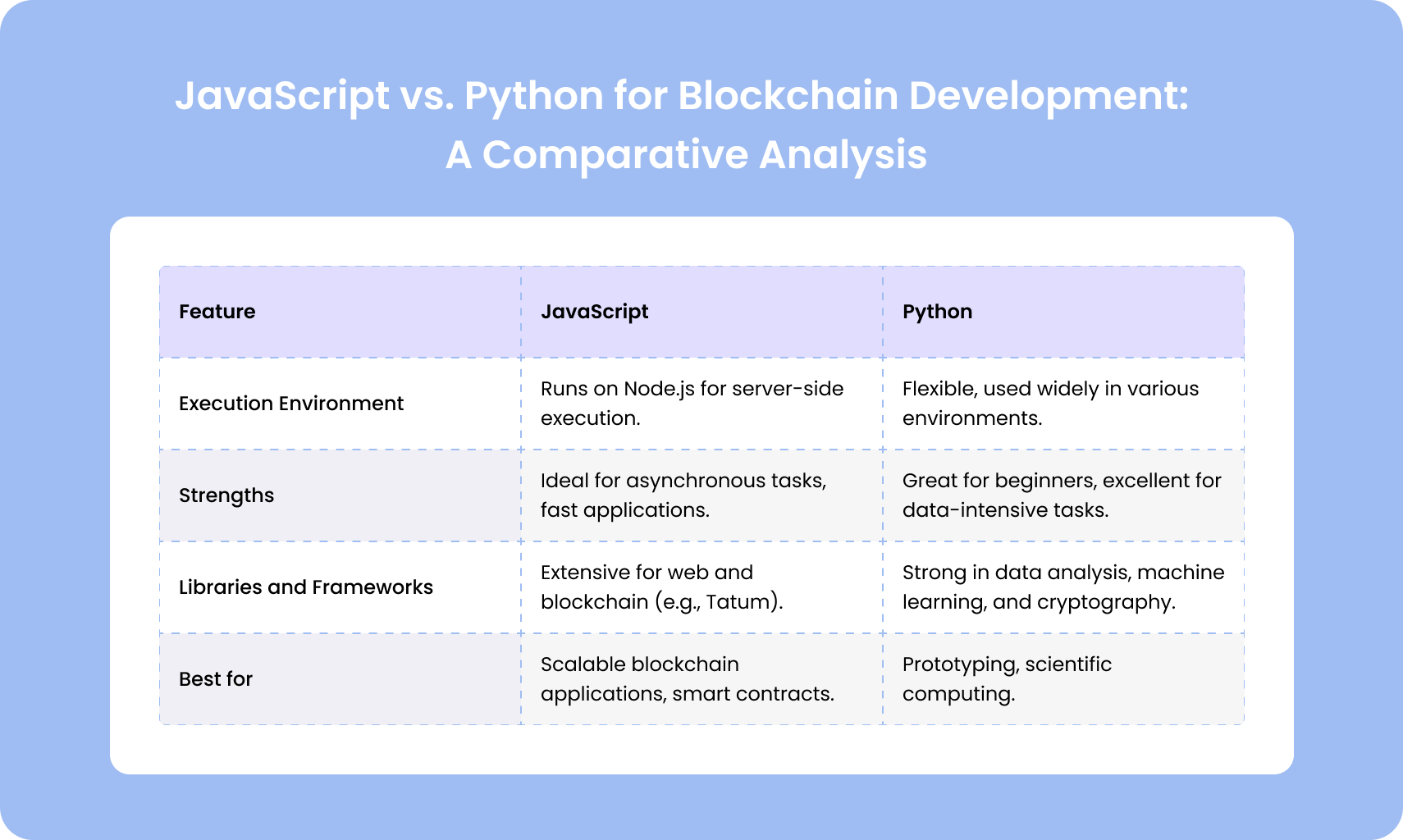Blockchain for Javascript Devs


Javascript has proven its widespread versatility, and its strength and flexibility make it a clear contender for use in blockchain development. The demands of developers are such that only those tools that are efficient, scalable and secure will do. Javascript fits the bill.
In this guide, we’re going to take you through how Javascript will not only help you build blockchain applications, but also release and manage them, too. We’ll look at the key benefits, capabilities and integration techniques, and how it all comes together to make the process as smooth as possible.
[.c-box-wow_wrapper][.c-box-wow][.c-wow-heading]JavaScript Blockchain Development Made Easy with Tatum[.c-wow-heading][.c-text-center]Blockchain network interactions are complicated. That’s why our API interface is designed to make the whole thing as simple as possible. Whether you’re a blockchain veteran or fresh on the scene, Tatum allows you to build robust blockchain solutions without getting bogged down by protocols.[.c-text-center][.c-box-wow][.c-box-wow_wrapper]
Your programming language is crucial when it comes to how efficient, how scalable and how secure your applications will be. When it comes to blockchain, Javascript and Python are the heavy hitters, and like all of us, they both have their strengths and weaknesses.
In a word: yes. In more words: Javascript’s versatility and flexibility make it a great fit for developing your blockchain applications, keeping them fast and allowing for huge potential. Server-side execution is possible by operating on the Node.js runtime, and benefits from a wide range of libraries and frameworks. Tatum is proud to be part of that and working on making development as easy as possible.
Python has a lot going for it. It’s very readable and its straightforward syntax makes things much simpler for those with less experience or short deadlines. There are a lot of people out there sharing knowledge, libraries for data analysis and machine learning, even cryptography. These things all play to Python’s advantage in the blockchain space, but when things get data-intensive, Python might not have Javascript’s performance.
Based on their individual strengths, either might work, depending on what you need. For projects with a wide range of functionalities like smart contracts and decentralized apps (DApps), as well as seamless integration with web technologies, Javascript is probably the way to go. But if quick prototyping is more important, or you are heavily data-driven, it might be better to choose Python.

Blockchain development might seem daunting for Javascript developers. That’s where we step in. Tatum’s API makes the whole thing much simpler, removing complexity and helping developers , even blockchain newcomers, get straight to work building their applications.
Tatum offers support for over 100 blockchain protocols, and this flexibility means, along with our API interface, that developers will be able to work across multiple blockchains like never before. And you won't get locked into a single technology, because who wants that?
Tatum might be easy, but it's also speedy. Our platform comes with a lot of functions ready to go, the ones that you're most likely to need - transactions, wallet creation and smart contracts - blink, and it's done.
Tailored for JavaScript and Node.js, Tatum's SDKs make integration a breeze, seamlessly crossing the divide on JavaScript projects.
[.c-box-wrapper][.c-box][.c-text-center]Are you lost in all the jargon? Check out our Crypto Glossary![.c-text-center][.c-box][.c-box-wrapper]
Want to have a go at building a blockchain application with Tatum and JavaScript? Here's a little tutorial!
For starters, sign up for a Tatum API key, which opens the vault door to Tatum’s wide range of functionalities. Just check out our documentation and take the first step to reaching your blockchain development goals.
Just start a new Node.js project and install our Tatum SDK:
One of the first things you'll want to do is make a Bitcoin wallet. Tatum's SDK makes it easier than opening a real wallet. Here's a quick guide on how to create one:
Up next, we have sending transactions, another must. Tatum streamlines the process, making it possible in just a few lines of code. Here's a small example of how to send a Bitcoin transaction:
It doesn't matter if you're building a decentralized application (DApp), making something for fintech or heading off into the world of NFTs or digital assets, Tatum will be there to support you, making things simpler and getting you where you're going fast.
With Tatum's SDK integrated into your JavaScript project, you can move your focus from the complexities to innovation.
We think you should definitely check these out if you're looking to up your blockchain development skills:
Let's start things off with Tatum's official documentation, the best place to go for comprehensive guides and API references.
As an overall guide to how blockchains and cryptocurrencies work, this is a fantastic resource, even for those who aren’t just interested in JavaScript.
Ethereum.org also provides a long list of tutorials and other development resources, for blockchain and more, including how JavaScript can be used for smart contracts and DApps.
Eloquent JavaScript is a great stop if you’re looking to level up your work in the language, for beginners and beyond - for blockchain is no exception.
Practice makes perfect, but with these resources, you’ll have a solid knowledge foundation that you can build your JavaScript blockchain development on. Big or small, simple or complex, whatever you’re envisioning, JavaScript and Tatum will help you get there.
So, if you’re looking to move into blockchain application development or want to build on what you’ve already achieved, JavaScript in tandem with Tatum is a powerful combination.
JavaScript’s versatility and Tatum’s API mean that your options are vast whilst keeping things straightforward and efficient.
And with our pre-built functions and resources to pull from, you’ll save loads of time and have more energy to put into what you want to build.
Reach your blockchain development goals with JavaScript and Tatum. Stable, scalable, secure.
[.c-wr-center][.c-copy-card][.c-copy-top][.c-copy-hex]npm i @tatumio/tatum[.c-copy-hex][.c-copy-top][$r-copy-to-clipboard=npm i @tatumio/tatum][.c-copy-icon][.c-copy-icon][$r-copy-to-clipboard][.c-tooltip]Copied![.c-tooltip][.c-copy-card][.button-blue-post]Get started[.button-blue-post][.c-wr-center]
Build blockchain apps faster with a unified framework for 60+ blockchain protocols.